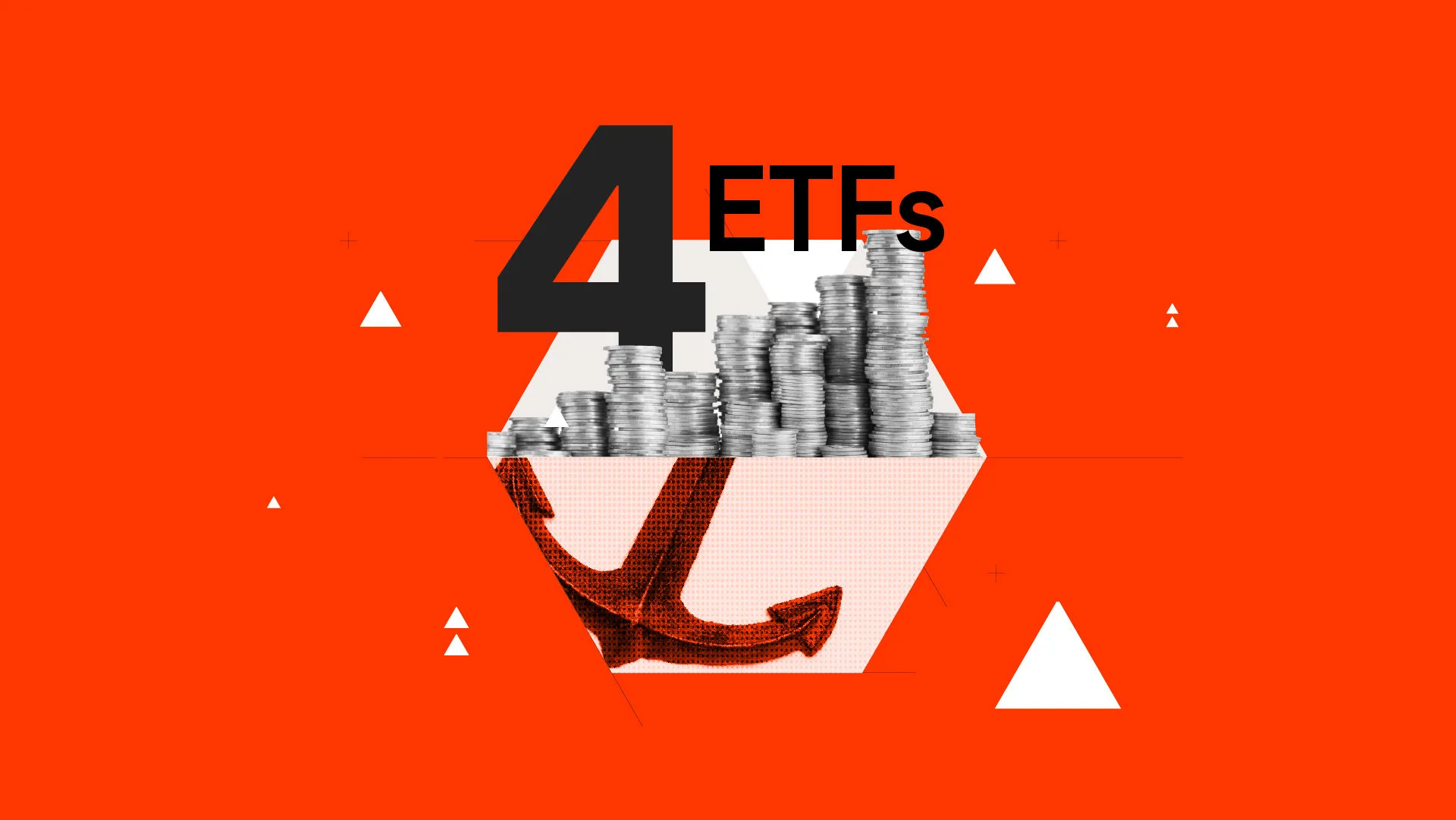4 ETFs to anchor your income in a declining yield environment
10 minutes reading time
As we enter a new financial year and focus turns to deploying capital and portfolio positioning, we share our investment team’s best ideas across major asset classes.
The below outlines two ETF implementation ideas each across Australian, US, and Global ex-US equities, secular themes, and fixed income.
Please note all past performance figures are as of 30 June 2025 and are not an indicator of future performance.
Australian Equities
Over the last year CBA accounted for 33% of the S&P/ASX 200 index total return, while the ‘Big 4’ plus Macquarie accounted for over 50%1.
Calling an end to Australia’s big banks’ rally has been a fool’s game. Nevertheless, investors should be looking to diversify portfolios, particularly into strategies that have outperformed the ASX 200 with an underweight position to the banks that make up so much of Australia’s broad index.
- Betashares Australia Quality ETF (ASX: AQLT)
- AQLT aims to track an index (before fees and expenses) that holds 40 companies comprising Australia’s large caps, re-weighted by their quality metrics rather than market capitalisation, and high quality mid- and small caps on the ASX.
- Despite AQLT’s largest active underweight position being CBA since fund inception the fund has outperformed the S&P/ASX 200 by, on average, 3.9% p.a., including 7.8% over the past 12 months2.
Amid a challenging period of underperformance, Australian small caps may now be primed for a reversal. Valuation dispersion between small and large caps has widened significantly and at the same time many companies in the sector have emerged from the rate hike cycle with stronger balance sheets and leaner operations3.
With interest rates expected to fall and domestic economic momentum stabilising, small caps, typically more sensitive to these shifts, may benefit more than large caps from any cyclical recovery.
- Betashares Australian Small Companies Select ETF (ASX: SMLL)
- SMLL aims to track an index (before fees and expenses) that provides exposure to a portfolio of high-quality, profitable small cap companies listed on the ASX.
- SMLL has outperformed the S&P/ASX Small Ordinaries Index by, on average, 0.6% p.a. since inception.4
US Equities
Beneath the surface of disruptive policy and geopolitical tension, corporate earnings in the US have remained robust helping to alleviate investors’ concerns of economic slowdowns dampening profits.
The US’ technology giants continue to achieve historic levels of earnings growth, collectively adding ~US$25b in nominal earnings for the 12 months to Q1 20255. By funneling their profits into further research and development they are keeping themselves at the forefront of innovation in areas key to future growth, like cloud, AI, cyber, advertising, and search.
- Betashares Nasdaq 100 ETF (ASX: NDQ) / Currency Hedged (ASX: HNDQ)
- NDQ aims to track the performance of the Nasdaq 100 Index (before fees and expenses), which provides Australian investors with exposure to some of the US’ largest technology companies including the ‘Magnificent 7’. Given the Australian market’s low exposure to the tech sector, NDQ can offer complementary exposure for Australian portfolios.
- NDQ has been one of the top performing Australian domiciled global equity funds over the past 10-years returning, on average, 20.1% p.a.6.
- HNDQ seeks to minimise the effect of currency fluctuations on returns. Investors may wish to consider HNDQ if they believe the USD could continue to depreciate against the AUD.
Promisingly, the broadening out narrative of US corporate earnings and performance that we have been flagging for some time is playing out. In particular, the industrial, utilities and financial sectors have all outperformed information technology year-to-date supported by improving underlying earnings growth. The promise of Trump’s policy pivot in H2 to market friendly agenda items like tax cuts and deregulations could provide further support for US-centric firms and sectors like financials and industrials going forward.
- Betashares S&P 500 Equal Weight ETF (ASX: QUS) / Currency Hedged (ASX: HQUS)
- QUS provides investors with broader diversification to US large caps and has higher allocations to sectors that may be set to benefit the most under Trump’s proposed policies.
- Globally we have seen significant flows into S&P 500 Equal Weight strategies approximating US$23b in the past 12 months7, as investors look to rebalance portfolios that have become overly concentrated in technology companies, and to position for the broadening equity market rally.
- HQUS seeks to minimise the effect of currency fluctuations on returns. Investors may wish to consider HQUS if they believe the USD could continue to depreciate against the AUD.
Global ex-US Equities
The AI narrative has undoubtedly driven much of the US share market’s return over recent years. However, with strong manufacturing capabilities and top-down government support, technology companies in Asia are emerging as a competing force in the AI arms race.
These companies are critical to the broader semiconductor supply chain, including chip foundries and memory chip manufacturers, but are also pioneering the development of more efficient, leading-edge AI models.
- Betashares Asia Technology Tigers ETF (ASX: ASIA)
- ASIA aims to track the performance of an index (before fees and expenses) that provides investors exposure to some of the largest technology and online retail companies in Asia (ex-Japan) including Alibaba, Tencent, TSMC and SK Hynix.
- ASIA offers exposure to a high-growth sector that is under-represented in the Australian sharemarket, and a complement to investors with US technology exposure.
India’s geopolitical stance and services driven export make-up has protected the economy in the short-term whilst its long-term structural growth story remains one of the strongest globally.
Additionally, the growing uptake of Systematic Investment Plans (SIP) and automatic monthly investments by the young urbanising population accounted for US$3bn of inflows in May8. These inflows are providing a strong foundation for the market and supports valuations, much like Australia’s monthly superannuation flows.
- Betashares India Quality ETF (ASX: IIND)
- IIND aims to track the performance of an index (before fees, expenses and taxes) and provide investors with diversified exposure to the highest quality Indian companies based on strong profitability, low debt levels, and high earnings stability.
- As a reflection of the region’s performance versus broader emerging markets, IIND has outperformed the MSCI Emerging Markets Index by, on average, 2.4% p.a. since its inception9.
Secular themes
NATO members’ recent declaration committing to spend 5% of GDP on defence by 2035 reaffirms the structural tailwinds driving global defence stocks over the past 12 months.
We expect Europe’s defence spending to reach 3% of GDP within the next five years, or an additional US$223bn per year in aggregate (based on 2024 GDP), a figure comparable to capital expenditure on AI infrastructure by the US technology giants.
- Betashares Global Defence ETF (ASX: ARMR)
- ARMR aims to track the performance of an index (before fees and expenses) that provides exposure to leading companies involved in the global defense sector. The index currently holds all of the top 20 defence contractors in the world by defence revenue, headquartered in NATO-aligned countries, including Lockheed Martin, BAE Systems, Rheinmetall, RTX, and Thales. These companies are set to be some of the largest beneficiaries of governments implementing the 5% GDP defence spending commitment.
- ARMR has returned 56.1% as of 30 June 2025 since its inception on 2 October 2024.
Clients seeking unique opportunities with growth and income potential in international equities, with very little overlap to typical high tech large cap exposure, could consider royalty companies.
Royalty companies offer a unique business model that can provide high margins and scalability, as they generate revenue based on a percentage of production or sale, without the significant capital or operational costs typically associated with developing and operating the underlying assets. This structure can help reduce exposure to certain operational and financial risks compared to traditional resource companies. They offer a unique return profile with low correlation to traditional asset classes, making them strong diversifiers with the potential to enhance portfolio risk-return outcomes[10].
- Betashares Global Royalties ETF (ASX: ROYL)
- ROYL aims to track the performance of an index (before fees and expenses) that provides exposure to a portfolio of global companies that earn a substantial portion of their revenue from royalty income, royalty related income and intellectual property income.
- ROYL has commenced monthly distributions that will generally aim to reflect the historical cash flow yield of the underlying portfolio. The prior 12-month cash flow yield of ROYL’s portfolio was 6.5% as of 31 December 202411.
- ROYL returned 28.7% over the past 12 months, and 18.4% p.a. since inception, with a correlation of .10 to the MSCI World Index12.
Fixed Income
The phasing out of bank hybrids and subsequent allocation decision for Australian investors has been a top of agenda item for many of our clients.
Betashares is one of Australia’s leading providers of fixed income ETFs, offering a range of solutions that advisors may consider when seeking to diversify or reduce concentration in direct hybrid holdings, across both short- and long-term investment horizons.13
Until they are phased out, bank hybrids will remain a compelling fixed income allocation due to the level of franked income they offer investors.
- Betashares Australian Major Bank Hybrids Index ETF (ASX: BHYB)
- BHYB holds a diversified portfolio of ‘Big 4’ hybrids. With the next first call date not until June 2026 and approximately 50% of the portfolio due to be called between 2029 and 2032, BHYB will continue to offer investors a simple way to maintain hybrid exposure in the coming years.
- BHYB has a trailing 12-month gross distribution yield of 6.5%14.
APRA’s new framework will see banks replace hybrids with mostly subordinated bonds for their funding needs. Subordinated bonds sit above hybrids in the current capital structure and offer yields that reflect their lower risk and greater protection
- Betashares Australian Major Bank Subordinated Debt ETF (ASX: BSUB)
- BSUB offers unique exposure to Tier 2 floating rate bonds issued exclusively by Australia’s big four banks, ensuring robust liquidity and may offer lower volatility and tighter trading spreads relative to less diversified or lower-rated bond exposures.
- BSUB is designed to harvest more yield and other forms of risk premium available from the highest quality issuers, while mitigating single security risk, maintaining strong credit quality and liquidity, and delivering a relatively stable volatility profile.
- BSUB has been the best performing index tracking subordinated bond ETF on the ASX since its inception on 6 May 2024 to 30 June 202515.
References
- Bloomberg, as at 30 June 2025.
- Returns as at 30 June 2025 since fund inception (4 April 2022). Past performance is not indicative of future results.
- Bloomberg company data, as at 30 June 2025.
- SMLL inception: 7 April 2017. Past performance is not indicative of future results.
- Company filings: AMZN, META, GOOGL, TSLA, MSFT, NVDA, AAPL.
- NDQ inception: 26 May 2015. Past performance is not indicative of future results.
- Bloomberg, as at 30 June 2025.
- Morningstar India.
- IIND inception: 2 August 2019. Past performance is not indicative of future results.
- Bloomberg, as at 30 June 2025. Based on historical performance and correlation.
- ROYL distributions aim to reflect historical cash flow yield. Actual yield may vary due to price appreciation.
- Bloomberg, daily correlation (1 July 2024 – 30 June 2025). Returns since fund inception (9 September 2022).
- As at 30 June 2025. Yield = 12-month distributions ÷ closing NAV. Franking level = total franking over 12 months.
- BSUB inception: 6 May 2024. Best performing by total returns. Past performance is not indicative of future results.



